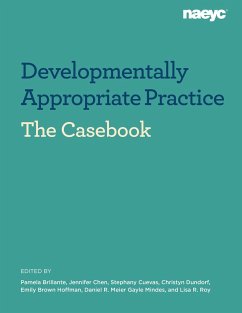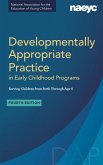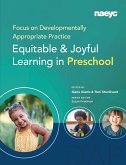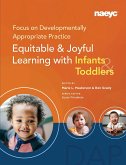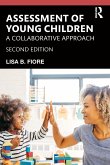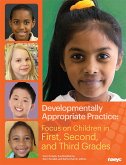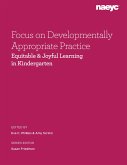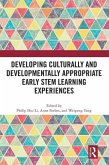Casebook: Developmentally Appropriate Practice in Early Childhood Programs Serving Children from Birth Through Age 8
Herausgeber: Brillante, Pamela; Roy, Lisa R; Mindes, Gayle; Meier, Daniel R; Brown Hoffman, Emily; Dundorf, Christyn; Cuevas, Stephany; Chen, Jennifer
Casebook: Developmentally Appropriate Practice in Early Childhood Programs Serving Children from Birth Through Age 8
Herausgeber: Brillante, Pamela; Roy, Lisa R; Mindes, Gayle; Meier, Daniel R; Brown Hoffman, Emily; Dundorf, Christyn; Cuevas, Stephany; Chen, Jennifer
- Broschiertes Buch
- Merkliste
- Auf die Merkliste
- Bewerten Bewerten
- Teilen
- Produkt teilen
- Produkterinnerung
- Produkterinnerung
Case studies provide real-world examples that make for rich discussions and greater learning in educational and professional development settings. Engage with case studies on developmentally appropriate practice to enhance your knowledge and skills. Developmentally appropriate practice (DAP) requires a nuanced understanding of child development, individual children, and the social and cultural contexts of children, families, and educators. This casebook presents nearly 50 cases addressing infancy through third grade and across multiple, diverse settings. Written and edited by teacher…mehr
Andere Kunden interessierten sich auch für
![Developmentally Appropriate Practice in Early Childhood Programs Serving Children from Birth Through Age 8, Fourth Edition (Fully Revised and Updated) Developmentally Appropriate Practice in Early Childhood Programs Serving Children from Birth Through Age 8, Fourth Edition (Fully Revised and Updated)]() NaeycDevelopmentally Appropriate Practice in Early Childhood Programs Serving Children from Birth Through Age 8, Fourth Edition (Fully Revised and Updated)64,99 €
NaeycDevelopmentally Appropriate Practice in Early Childhood Programs Serving Children from Birth Through Age 8, Fourth Edition (Fully Revised and Updated)64,99 €![Focus on Developmentally Appropriate Practice Focus on Developmentally Appropriate Practice]() Focus on Developmentally Appropriate Practice31,99 €
Focus on Developmentally Appropriate Practice31,99 €![Focus on Developmentally Appropriate Practice Focus on Developmentally Appropriate Practice]() Focus on Developmentally Appropriate Practice28,99 €
Focus on Developmentally Appropriate Practice28,99 €![Assessment of Young Children Assessment of Young Children]() Lisa B. Fiore (USA Lesley University)Assessment of Young Children54,99 €
Lisa B. Fiore (USA Lesley University)Assessment of Young Children54,99 €![Developmentally Appropriate Practice Developmentally Appropriate Practice]() Sue BredekampDevelopmentally Appropriate Practice43,99 €
Sue BredekampDevelopmentally Appropriate Practice43,99 €![Focus on Developmentally Appropriate Practice Focus on Developmentally Appropriate Practice]() Focus on Developmentally Appropriate Practice31,99 €
Focus on Developmentally Appropriate Practice31,99 €![Developing Culturally and Developmentally Appropriate Early STEM Learning Experiences Developing Culturally and Developmentally Appropriate Early STEM Learning Experiences]() Developing Culturally and Developmentally Appropriate Early STEM Learning Experiences154,99 €
Developing Culturally and Developmentally Appropriate Early STEM Learning Experiences154,99 €-
-
-
Case studies provide real-world examples that make for rich discussions and greater learning in educational and professional development settings. Engage with case studies on developmentally appropriate practice to enhance your knowledge and skills. Developmentally appropriate practice (DAP) requires a nuanced understanding of child development, individual children, and the social and cultural contexts of children, families, and educators. This casebook presents nearly 50 cases addressing infancy through third grade and across multiple, diverse settings. Written and edited by teacher educators, researchers, classroom teachers, and other early childhood professionals, these cases offer unique opportunities for critical thinking and discussion on practice that supports all children and families. The cases are organized into eight parts that reflect the six guidelines of DAP plus the topics of supporting children with disabilities and supporting dual language learners. Brief overviews of each guideline and the additional topics set the stage for study of the cases. Each case provides an opportunity to * Make connections to the fourth edition of Developmentally Appropriate Practice in Early Childhood Programs * Think critically about the influence of context on educator, child, and family actions * Discuss the effectiveness of the teaching practices and how they might be improved * Support your responses with evidence from the DAP position statement and book * Explore next steps beyond the case details * Apply the learning to your own situation Use this book as a companion to the fourth edition of Developmentally Appropriate Practice in Early Childhood Programs in higher education coursework, as professional development in programs, or for stand-alone study.
Produktdetails
- Produktdetails
- Verlag: National Association for the Education of Young Children
- Seitenzahl: 208
- Erscheinungstermin: 21. Februar 2023
- Englisch
- Abmessung: 274mm x 211mm x 13mm
- Gewicht: 568g
- ISBN-13: 9781952331121
- ISBN-10: 1952331129
- Artikelnr.: 63365533
- Herstellerkennzeichnung
- Libri GmbH
- Europaallee 1
- 36244 Bad Hersfeld
- gpsr@libri.de
- Verlag: National Association for the Education of Young Children
- Seitenzahl: 208
- Erscheinungstermin: 21. Februar 2023
- Englisch
- Abmessung: 274mm x 211mm x 13mm
- Gewicht: 568g
- ISBN-13: 9781952331121
- ISBN-10: 1952331129
- Artikelnr.: 63365533
- Herstellerkennzeichnung
- Libri GmbH
- Europaallee 1
- 36244 Bad Hersfeld
- gpsr@libri.de
Pamela Brillante, EdD, is professor in the Department of Special Education, Professional Counseling and Disability Studies, at William Paterson University. She has worked as an early childhood special educator, administrator, and New Jersey state specialist in early childhood special education. She is the author of the NAEYC book The Essentials: Supporting Young Children with Disabilities in the Classroom. Dr. Brillante continues to work with schools to develop high-quality inclusive early childhood programs. Jennifer J. Chen, EdD, is professor of early childhood and family studies at Kean University. She earned her doctorate from Harvard University. She has authored or coauthored more than 60 publications in early childhood education. Dr. Chen has received several awards, including the 2020 NAECTE Foundation Established Career Award for Research on ECTE, the 2021 Kean Presidential Excellence Award for Distinguished Scholarship, and the 2022 NJAECTE’s Distinguished Scholarship in ECTE/ECE Award. Stephany Cuevas, EdD, is assistant professor of education in the Attallah College of Educational Studies at Chapman University. Dr. Cuevas is an interdisciplinary education scholar whose research focuses on family engagement, Latinx families, and the postsecondary trajectories of first-generation students. She is the author of Apoyo Sacrifical, Sacrificial Support: How Undocumented Parents Get Their Children to College (Teachers College Press). Christyn Dundorf, PhD, has more than 30 years of experience in the early learning field as a teacher, administrator, and adult educator. She serves as codirector of Teaching Preschool Partners, a nonprofit organization working to grow playful learning and inquiry practices in school-based pre-K programs and infuse those practices up into the early grades. Emily Brown Hoffman, PhD, is assistant professor in early childhood education at National Louis University in Chicago. She received her PhD from the University of Illinois at Chicago in Curriculum & Instruction, Literacy, Language, & Culture. Her focuses include emergent literacy, leadership, play and creativity, and school, family, and community partnerships. Daniel R. Meier, PhD, is professor of elementary education at San Francisco State University. His publications include Critical Issues in Infant-Toddler Language Development: Connecting Theory to Practice (editor), Supporting Literacies for Children of Color: A Strength-Based Approach to Preschool Literacy (author), and Learning Stories and Teacher Inquiry Groups: Reimagining Teaching and Assessment in Early Childhood Education (coauthor). Gayle Mindes, EdD, is professor emerita, DePaul University. She is the author of Assessing Young Children, fifth edition (with Lee Ann Jung), and Social Studies for Young Children: Preschool and Primary Curriculum Anchor, third edition (with Mark Newman). Dr. Mindes is also the editor of Teaching Young Children with Challenging Behaviors: Practical Strategies for Early Childhood Educators and Contemporary Challenges in Teaching Young Children: Meeting the Needs of All Students. Lisa R. Roy, EdD, is executive director for the Colorado Department of Early Childhood. Dr. Roy has supported families with young children for over 30 years, serving as the director of program development for the Buffett Early Childhood Institute, as the executive director of early childhood education for Denver Public Schools, and in various nonprofit and government roles.
Editors, Contributors, and Reviewers
Introduction and Book Overview Jennifer J. Chen and Dana Battaglia
Part 1: Creating a Caring, Equitable Community of Learners Lisa R. Roy
1.1 Missed Opportunities: Relationship Building in Inclusive Classrooms
Julia Torquati
1.2 “My Name Is Not a Shame” Kevin McGowan
1.3 Fostering Developmentally Appropriate Practice Through Virtual Family
Connections Lea Ann Christenson
1.4 Counting Collections in Community Amy Schmidtke
1.5 The Joy Jar: Celebrating Kindness Leah Schoenberg Muccio
1.6 Prioritizing Listening to and Learning from Families Amy Schmidtke
Part 2: Engaging in Reciprocal Partnerships with Families and Fostering
Community Connections Stephany Cuevas
2.1 Julio’s Village: Early Childhood Education Supports for Teen Parents
Donna Kirkwood
2.2 Healthy Boundaries: Listening to Children and Learning from Families
Jovanna Archuleta
2.3 Roadmap of Family Engagement to Kindergarten: An Ecological Systems
Approach Marcela Andrés
2.4 Taking Trust for Granted? The Importance of Communication and Outreach
in Family Partnerships Suzanna Ewert
2.5 Book Reading: Learning About Migration and Our Family Stories Sarah
Rendón García
Part 3: Observing, Documenting, and Assessing Children’s Development and
Learning Gayle Mindes
3.1 Pairing Standardized Scale with Observation Megan Schumaker-Murphy
3.2 The Power of Observing Jordan Marsha Shigeyo Hawley and Barbara Abel
3.3 “But What Is My Child Learning?” Janet Thompson and Jennifer
Gonzalez
3.4 Drawing and Dialogue: Using Authentic Assessment to Understand
Children’s Sense
of Self and Observe Early Literacy Skills Brandon L. Gilbert
3.5 The ABCs of Kindergarten Registration: Assessment, Background, and
Collaboration Between Home and School Bridget Amory
3.6 Creating Opportunities for Individualized Assessment Activities for
Biliteracy Development Esther Garza
3.7 Observing Second-Graders’ Vocabulary Development Marie Ann Donovan
3.8 Writing Isn’t the Only Way! Multiple Means of Expressing Learning Lee
Ann Jungiv
Part 4: Teaching to Enhance Each Child’s Development and Learning Emily
Brown Hoffman
4.1 Engaging with Families to Individualize Teaching Marie L. Masterson
4.2 Tumbling Towers with Toddlers: Intention and Decision Making Over
Blocks Ron Grady
4.3 What My Heart Holds: Exploring Identity with Preschool Learners
Cierra Kaler-Jones
4.4 “I See a Really Big Gecko!” When Background Knowledge and Teaching
Materials Don’t Match Germaine Kaleilehua Tauati and Colleen E.
Whittingham
4.5 Using a Humanizing and Restorative Approach for Young Children to
Develop Responsibility and Self-Regulation Saili S. Kulkarni, Sunyoung
Kim, and Nicola Holdman
4.6 Joyful, Developmentally Appropriate Learning Environments for African
American Youth Lauren C. Mims, Addison Duane, LaKenya Johnson, and Erika
Bocknek
Part 5: Planning and Implementing an Engaging Curriculum to Achieve
Meaningful Goals Daniel R. Meier
5.1 Using the Environment and Materials as Curriculum for Promoting
Infants’ and Toddlers’ Exploration of Basic Cause-and-Effect Principles
Guadalupe Rivas
5.2 Social Play Connections Among a Small Group of Preschoolers Leah
Catching
5.3 Can Preschoolers Code? A Sneak Peek into a Developmentally Appropriate
Coding Lesson Olabisi Adesuyi-Fasuyi
5.4 Everyday Gifts: Children Show Us the Path—We Observe and Scaffold
Martha Melgoza
5.5 Learning to Conquer the Slide Through Persistence and Engaging in
Social Interaction Sueli Nunes
5.6 “Sabes que todos los caracoles pueden tener bebés? Do You Know that All
Snails Can Have Babies?” Supporting Children’s Emerging Interests in a Dual
Language Preschool Classroom Isauro M. Escamilla
5.7 “Can We Read this One?” A Conversation About Book Selection in
Kindergarten Larissa Hsia-Wong
Part 6: Demonstrating Professionalism as an Early Childhood Educator
Christyn Dundorf
6.1 Take a Chance on Coaching: It’s Worth It! Lauren Bond
6.2 It Started with a Friendship Parade Angela Vargas
6.3 The World Outside of the Classroom: Letting Your Voice Be Heard
Meghann Hickey
Part 7: Supporting Children with Disabilities and Implementing Inclusive
Practices Pamela Brillante
7.1 Communication as a Two-Way Street? Creating Opportunities for
Engagement During Meaningful Language Routines Kameron C. Cardenv
7.2 Eli Goes to Preschool: Inclusion for a Child with Autism Spectrum
Disorder Abby Hodges
7.3 Preschool Classroom Supports and Embedded Interventions with Coteaching
Racheal Kuperus and Desarae Orgo
7.4 Addressing Challenging Behavior Using the Pyramid Model Ellie Bold
7.5 Dual Language or Disability? How Teachers Can Be the First to Help
Alyssa Brillante
7.6 Adapting and Modifying Instruction Using Reader’s Theater Michelle
Gonzalez
7.7 Supporting Children with Learning Disabilities in Mathematics: The
Importance of Observation, Content Knowledge, and Context Renee B.
Whelan
Part 8: Supporting Dual Language Learners and Respecting Cultural and
Linguistic Diversity Jennifer J. Chen
8.1 Facilitating a Child’s Transition from Home to Group Care Through the
Use of Cultural Caring Routines Josephine Ahmadein
8.2 Engaging Dual Language Learners in Conversation to Support
Translanguaging During a Small Group Activity Valeria Erdosi and Jennifer
J. Chen
8.3 Incorporating Children’s Cultures and Languages in Learning Activities
Eleni Zgourou
8.4 Adapting Teaching Materials for Dual Language Learners to Reflect Their
Home Languages and Cultures in a Math Lesson Karen Nemeth
8.5 Studying Celestial Bodies: Science and Cultural Stories Zeynep
Isik-Ercan
8.6 Respecting Diverse Cultures and Languages by Sharing and Learning About
Cultural Poems, Songs, and Stories From Others Janis Strasser
Index
Introduction and Book Overview Jennifer J. Chen and Dana Battaglia
Part 1: Creating a Caring, Equitable Community of Learners Lisa R. Roy
1.1 Missed Opportunities: Relationship Building in Inclusive Classrooms
Julia Torquati
1.2 “My Name Is Not a Shame” Kevin McGowan
1.3 Fostering Developmentally Appropriate Practice Through Virtual Family
Connections Lea Ann Christenson
1.4 Counting Collections in Community Amy Schmidtke
1.5 The Joy Jar: Celebrating Kindness Leah Schoenberg Muccio
1.6 Prioritizing Listening to and Learning from Families Amy Schmidtke
Part 2: Engaging in Reciprocal Partnerships with Families and Fostering
Community Connections Stephany Cuevas
2.1 Julio’s Village: Early Childhood Education Supports for Teen Parents
Donna Kirkwood
2.2 Healthy Boundaries: Listening to Children and Learning from Families
Jovanna Archuleta
2.3 Roadmap of Family Engagement to Kindergarten: An Ecological Systems
Approach Marcela Andrés
2.4 Taking Trust for Granted? The Importance of Communication and Outreach
in Family Partnerships Suzanna Ewert
2.5 Book Reading: Learning About Migration and Our Family Stories Sarah
Rendón García
Part 3: Observing, Documenting, and Assessing Children’s Development and
Learning Gayle Mindes
3.1 Pairing Standardized Scale with Observation Megan Schumaker-Murphy
3.2 The Power of Observing Jordan Marsha Shigeyo Hawley and Barbara Abel
3.3 “But What Is My Child Learning?” Janet Thompson and Jennifer
Gonzalez
3.4 Drawing and Dialogue: Using Authentic Assessment to Understand
Children’s Sense
of Self and Observe Early Literacy Skills Brandon L. Gilbert
3.5 The ABCs of Kindergarten Registration: Assessment, Background, and
Collaboration Between Home and School Bridget Amory
3.6 Creating Opportunities for Individualized Assessment Activities for
Biliteracy Development Esther Garza
3.7 Observing Second-Graders’ Vocabulary Development Marie Ann Donovan
3.8 Writing Isn’t the Only Way! Multiple Means of Expressing Learning Lee
Ann Jungiv
Part 4: Teaching to Enhance Each Child’s Development and Learning Emily
Brown Hoffman
4.1 Engaging with Families to Individualize Teaching Marie L. Masterson
4.2 Tumbling Towers with Toddlers: Intention and Decision Making Over
Blocks Ron Grady
4.3 What My Heart Holds: Exploring Identity with Preschool Learners
Cierra Kaler-Jones
4.4 “I See a Really Big Gecko!” When Background Knowledge and Teaching
Materials Don’t Match Germaine Kaleilehua Tauati and Colleen E.
Whittingham
4.5 Using a Humanizing and Restorative Approach for Young Children to
Develop Responsibility and Self-Regulation Saili S. Kulkarni, Sunyoung
Kim, and Nicola Holdman
4.6 Joyful, Developmentally Appropriate Learning Environments for African
American Youth Lauren C. Mims, Addison Duane, LaKenya Johnson, and Erika
Bocknek
Part 5: Planning and Implementing an Engaging Curriculum to Achieve
Meaningful Goals Daniel R. Meier
5.1 Using the Environment and Materials as Curriculum for Promoting
Infants’ and Toddlers’ Exploration of Basic Cause-and-Effect Principles
Guadalupe Rivas
5.2 Social Play Connections Among a Small Group of Preschoolers Leah
Catching
5.3 Can Preschoolers Code? A Sneak Peek into a Developmentally Appropriate
Coding Lesson Olabisi Adesuyi-Fasuyi
5.4 Everyday Gifts: Children Show Us the Path—We Observe and Scaffold
Martha Melgoza
5.5 Learning to Conquer the Slide Through Persistence and Engaging in
Social Interaction Sueli Nunes
5.6 “Sabes que todos los caracoles pueden tener bebés? Do You Know that All
Snails Can Have Babies?” Supporting Children’s Emerging Interests in a Dual
Language Preschool Classroom Isauro M. Escamilla
5.7 “Can We Read this One?” A Conversation About Book Selection in
Kindergarten Larissa Hsia-Wong
Part 6: Demonstrating Professionalism as an Early Childhood Educator
Christyn Dundorf
6.1 Take a Chance on Coaching: It’s Worth It! Lauren Bond
6.2 It Started with a Friendship Parade Angela Vargas
6.3 The World Outside of the Classroom: Letting Your Voice Be Heard
Meghann Hickey
Part 7: Supporting Children with Disabilities and Implementing Inclusive
Practices Pamela Brillante
7.1 Communication as a Two-Way Street? Creating Opportunities for
Engagement During Meaningful Language Routines Kameron C. Cardenv
7.2 Eli Goes to Preschool: Inclusion for a Child with Autism Spectrum
Disorder Abby Hodges
7.3 Preschool Classroom Supports and Embedded Interventions with Coteaching
Racheal Kuperus and Desarae Orgo
7.4 Addressing Challenging Behavior Using the Pyramid Model Ellie Bold
7.5 Dual Language or Disability? How Teachers Can Be the First to Help
Alyssa Brillante
7.6 Adapting and Modifying Instruction Using Reader’s Theater Michelle
Gonzalez
7.7 Supporting Children with Learning Disabilities in Mathematics: The
Importance of Observation, Content Knowledge, and Context Renee B.
Whelan
Part 8: Supporting Dual Language Learners and Respecting Cultural and
Linguistic Diversity Jennifer J. Chen
8.1 Facilitating a Child’s Transition from Home to Group Care Through the
Use of Cultural Caring Routines Josephine Ahmadein
8.2 Engaging Dual Language Learners in Conversation to Support
Translanguaging During a Small Group Activity Valeria Erdosi and Jennifer
J. Chen
8.3 Incorporating Children’s Cultures and Languages in Learning Activities
Eleni Zgourou
8.4 Adapting Teaching Materials for Dual Language Learners to Reflect Their
Home Languages and Cultures in a Math Lesson Karen Nemeth
8.5 Studying Celestial Bodies: Science and Cultural Stories Zeynep
Isik-Ercan
8.6 Respecting Diverse Cultures and Languages by Sharing and Learning About
Cultural Poems, Songs, and Stories From Others Janis Strasser
Index
Editors, Contributors, and Reviewers
Introduction and Book Overview Jennifer J. Chen and Dana Battaglia
Part 1: Creating a Caring, Equitable Community of Learners Lisa R. Roy
1.1 Missed Opportunities: Relationship Building in Inclusive Classrooms
Julia Torquati
1.2 “My Name Is Not a Shame” Kevin McGowan
1.3 Fostering Developmentally Appropriate Practice Through Virtual Family
Connections Lea Ann Christenson
1.4 Counting Collections in Community Amy Schmidtke
1.5 The Joy Jar: Celebrating Kindness Leah Schoenberg Muccio
1.6 Prioritizing Listening to and Learning from Families Amy Schmidtke
Part 2: Engaging in Reciprocal Partnerships with Families and Fostering
Community Connections Stephany Cuevas
2.1 Julio’s Village: Early Childhood Education Supports for Teen Parents
Donna Kirkwood
2.2 Healthy Boundaries: Listening to Children and Learning from Families
Jovanna Archuleta
2.3 Roadmap of Family Engagement to Kindergarten: An Ecological Systems
Approach Marcela Andrés
2.4 Taking Trust for Granted? The Importance of Communication and Outreach
in Family Partnerships Suzanna Ewert
2.5 Book Reading: Learning About Migration and Our Family Stories Sarah
Rendón García
Part 3: Observing, Documenting, and Assessing Children’s Development and
Learning Gayle Mindes
3.1 Pairing Standardized Scale with Observation Megan Schumaker-Murphy
3.2 The Power of Observing Jordan Marsha Shigeyo Hawley and Barbara Abel
3.3 “But What Is My Child Learning?” Janet Thompson and Jennifer
Gonzalez
3.4 Drawing and Dialogue: Using Authentic Assessment to Understand
Children’s Sense
of Self and Observe Early Literacy Skills Brandon L. Gilbert
3.5 The ABCs of Kindergarten Registration: Assessment, Background, and
Collaboration Between Home and School Bridget Amory
3.6 Creating Opportunities for Individualized Assessment Activities for
Biliteracy Development Esther Garza
3.7 Observing Second-Graders’ Vocabulary Development Marie Ann Donovan
3.8 Writing Isn’t the Only Way! Multiple Means of Expressing Learning Lee
Ann Jungiv
Part 4: Teaching to Enhance Each Child’s Development and Learning Emily
Brown Hoffman
4.1 Engaging with Families to Individualize Teaching Marie L. Masterson
4.2 Tumbling Towers with Toddlers: Intention and Decision Making Over
Blocks Ron Grady
4.3 What My Heart Holds: Exploring Identity with Preschool Learners
Cierra Kaler-Jones
4.4 “I See a Really Big Gecko!” When Background Knowledge and Teaching
Materials Don’t Match Germaine Kaleilehua Tauati and Colleen E.
Whittingham
4.5 Using a Humanizing and Restorative Approach for Young Children to
Develop Responsibility and Self-Regulation Saili S. Kulkarni, Sunyoung
Kim, and Nicola Holdman
4.6 Joyful, Developmentally Appropriate Learning Environments for African
American Youth Lauren C. Mims, Addison Duane, LaKenya Johnson, and Erika
Bocknek
Part 5: Planning and Implementing an Engaging Curriculum to Achieve
Meaningful Goals Daniel R. Meier
5.1 Using the Environment and Materials as Curriculum for Promoting
Infants’ and Toddlers’ Exploration of Basic Cause-and-Effect Principles
Guadalupe Rivas
5.2 Social Play Connections Among a Small Group of Preschoolers Leah
Catching
5.3 Can Preschoolers Code? A Sneak Peek into a Developmentally Appropriate
Coding Lesson Olabisi Adesuyi-Fasuyi
5.4 Everyday Gifts: Children Show Us the Path—We Observe and Scaffold
Martha Melgoza
5.5 Learning to Conquer the Slide Through Persistence and Engaging in
Social Interaction Sueli Nunes
5.6 “Sabes que todos los caracoles pueden tener bebés? Do You Know that All
Snails Can Have Babies?” Supporting Children’s Emerging Interests in a Dual
Language Preschool Classroom Isauro M. Escamilla
5.7 “Can We Read this One?” A Conversation About Book Selection in
Kindergarten Larissa Hsia-Wong
Part 6: Demonstrating Professionalism as an Early Childhood Educator
Christyn Dundorf
6.1 Take a Chance on Coaching: It’s Worth It! Lauren Bond
6.2 It Started with a Friendship Parade Angela Vargas
6.3 The World Outside of the Classroom: Letting Your Voice Be Heard
Meghann Hickey
Part 7: Supporting Children with Disabilities and Implementing Inclusive
Practices Pamela Brillante
7.1 Communication as a Two-Way Street? Creating Opportunities for
Engagement During Meaningful Language Routines Kameron C. Cardenv
7.2 Eli Goes to Preschool: Inclusion for a Child with Autism Spectrum
Disorder Abby Hodges
7.3 Preschool Classroom Supports and Embedded Interventions with Coteaching
Racheal Kuperus and Desarae Orgo
7.4 Addressing Challenging Behavior Using the Pyramid Model Ellie Bold
7.5 Dual Language or Disability? How Teachers Can Be the First to Help
Alyssa Brillante
7.6 Adapting and Modifying Instruction Using Reader’s Theater Michelle
Gonzalez
7.7 Supporting Children with Learning Disabilities in Mathematics: The
Importance of Observation, Content Knowledge, and Context Renee B.
Whelan
Part 8: Supporting Dual Language Learners and Respecting Cultural and
Linguistic Diversity Jennifer J. Chen
8.1 Facilitating a Child’s Transition from Home to Group Care Through the
Use of Cultural Caring Routines Josephine Ahmadein
8.2 Engaging Dual Language Learners in Conversation to Support
Translanguaging During a Small Group Activity Valeria Erdosi and Jennifer
J. Chen
8.3 Incorporating Children’s Cultures and Languages in Learning Activities
Eleni Zgourou
8.4 Adapting Teaching Materials for Dual Language Learners to Reflect Their
Home Languages and Cultures in a Math Lesson Karen Nemeth
8.5 Studying Celestial Bodies: Science and Cultural Stories Zeynep
Isik-Ercan
8.6 Respecting Diverse Cultures and Languages by Sharing and Learning About
Cultural Poems, Songs, and Stories From Others Janis Strasser
Index
Introduction and Book Overview Jennifer J. Chen and Dana Battaglia
Part 1: Creating a Caring, Equitable Community of Learners Lisa R. Roy
1.1 Missed Opportunities: Relationship Building in Inclusive Classrooms
Julia Torquati
1.2 “My Name Is Not a Shame” Kevin McGowan
1.3 Fostering Developmentally Appropriate Practice Through Virtual Family
Connections Lea Ann Christenson
1.4 Counting Collections in Community Amy Schmidtke
1.5 The Joy Jar: Celebrating Kindness Leah Schoenberg Muccio
1.6 Prioritizing Listening to and Learning from Families Amy Schmidtke
Part 2: Engaging in Reciprocal Partnerships with Families and Fostering
Community Connections Stephany Cuevas
2.1 Julio’s Village: Early Childhood Education Supports for Teen Parents
Donna Kirkwood
2.2 Healthy Boundaries: Listening to Children and Learning from Families
Jovanna Archuleta
2.3 Roadmap of Family Engagement to Kindergarten: An Ecological Systems
Approach Marcela Andrés
2.4 Taking Trust for Granted? The Importance of Communication and Outreach
in Family Partnerships Suzanna Ewert
2.5 Book Reading: Learning About Migration and Our Family Stories Sarah
Rendón García
Part 3: Observing, Documenting, and Assessing Children’s Development and
Learning Gayle Mindes
3.1 Pairing Standardized Scale with Observation Megan Schumaker-Murphy
3.2 The Power of Observing Jordan Marsha Shigeyo Hawley and Barbara Abel
3.3 “But What Is My Child Learning?” Janet Thompson and Jennifer
Gonzalez
3.4 Drawing and Dialogue: Using Authentic Assessment to Understand
Children’s Sense
of Self and Observe Early Literacy Skills Brandon L. Gilbert
3.5 The ABCs of Kindergarten Registration: Assessment, Background, and
Collaboration Between Home and School Bridget Amory
3.6 Creating Opportunities for Individualized Assessment Activities for
Biliteracy Development Esther Garza
3.7 Observing Second-Graders’ Vocabulary Development Marie Ann Donovan
3.8 Writing Isn’t the Only Way! Multiple Means of Expressing Learning Lee
Ann Jungiv
Part 4: Teaching to Enhance Each Child’s Development and Learning Emily
Brown Hoffman
4.1 Engaging with Families to Individualize Teaching Marie L. Masterson
4.2 Tumbling Towers with Toddlers: Intention and Decision Making Over
Blocks Ron Grady
4.3 What My Heart Holds: Exploring Identity with Preschool Learners
Cierra Kaler-Jones
4.4 “I See a Really Big Gecko!” When Background Knowledge and Teaching
Materials Don’t Match Germaine Kaleilehua Tauati and Colleen E.
Whittingham
4.5 Using a Humanizing and Restorative Approach for Young Children to
Develop Responsibility and Self-Regulation Saili S. Kulkarni, Sunyoung
Kim, and Nicola Holdman
4.6 Joyful, Developmentally Appropriate Learning Environments for African
American Youth Lauren C. Mims, Addison Duane, LaKenya Johnson, and Erika
Bocknek
Part 5: Planning and Implementing an Engaging Curriculum to Achieve
Meaningful Goals Daniel R. Meier
5.1 Using the Environment and Materials as Curriculum for Promoting
Infants’ and Toddlers’ Exploration of Basic Cause-and-Effect Principles
Guadalupe Rivas
5.2 Social Play Connections Among a Small Group of Preschoolers Leah
Catching
5.3 Can Preschoolers Code? A Sneak Peek into a Developmentally Appropriate
Coding Lesson Olabisi Adesuyi-Fasuyi
5.4 Everyday Gifts: Children Show Us the Path—We Observe and Scaffold
Martha Melgoza
5.5 Learning to Conquer the Slide Through Persistence and Engaging in
Social Interaction Sueli Nunes
5.6 “Sabes que todos los caracoles pueden tener bebés? Do You Know that All
Snails Can Have Babies?” Supporting Children’s Emerging Interests in a Dual
Language Preschool Classroom Isauro M. Escamilla
5.7 “Can We Read this One?” A Conversation About Book Selection in
Kindergarten Larissa Hsia-Wong
Part 6: Demonstrating Professionalism as an Early Childhood Educator
Christyn Dundorf
6.1 Take a Chance on Coaching: It’s Worth It! Lauren Bond
6.2 It Started with a Friendship Parade Angela Vargas
6.3 The World Outside of the Classroom: Letting Your Voice Be Heard
Meghann Hickey
Part 7: Supporting Children with Disabilities and Implementing Inclusive
Practices Pamela Brillante
7.1 Communication as a Two-Way Street? Creating Opportunities for
Engagement During Meaningful Language Routines Kameron C. Cardenv
7.2 Eli Goes to Preschool: Inclusion for a Child with Autism Spectrum
Disorder Abby Hodges
7.3 Preschool Classroom Supports and Embedded Interventions with Coteaching
Racheal Kuperus and Desarae Orgo
7.4 Addressing Challenging Behavior Using the Pyramid Model Ellie Bold
7.5 Dual Language or Disability? How Teachers Can Be the First to Help
Alyssa Brillante
7.6 Adapting and Modifying Instruction Using Reader’s Theater Michelle
Gonzalez
7.7 Supporting Children with Learning Disabilities in Mathematics: The
Importance of Observation, Content Knowledge, and Context Renee B.
Whelan
Part 8: Supporting Dual Language Learners and Respecting Cultural and
Linguistic Diversity Jennifer J. Chen
8.1 Facilitating a Child’s Transition from Home to Group Care Through the
Use of Cultural Caring Routines Josephine Ahmadein
8.2 Engaging Dual Language Learners in Conversation to Support
Translanguaging During a Small Group Activity Valeria Erdosi and Jennifer
J. Chen
8.3 Incorporating Children’s Cultures and Languages in Learning Activities
Eleni Zgourou
8.4 Adapting Teaching Materials for Dual Language Learners to Reflect Their
Home Languages and Cultures in a Math Lesson Karen Nemeth
8.5 Studying Celestial Bodies: Science and Cultural Stories Zeynep
Isik-Ercan
8.6 Respecting Diverse Cultures and Languages by Sharing and Learning About
Cultural Poems, Songs, and Stories From Others Janis Strasser
Index

